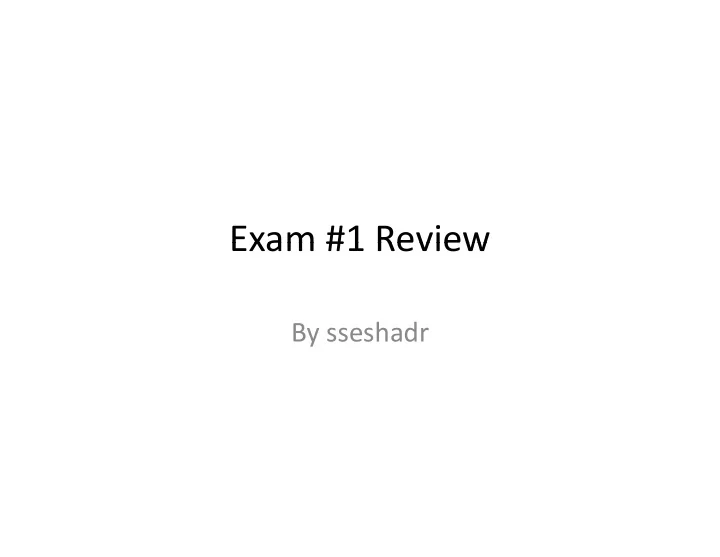

Exam #1 Review Exam #1 Review By sseshadr
Agenda Agenda • Reminders Reminders – Test tomorrow! • One 8.5 x 11 sheet, two sides – Pick up your datalabs in OH – Cachelab comes out tomorrow • Review • Questions Q
[Subset of] What to Know [Subset of] What to Know Labs! • – We try to reward people who did them well Assembly • – Basics (what does cmp do, source vs. dest, operand order for add, etc )? etc.)? – What registers are special? Caller save vs. callee save? – Switch statements and jump tables? – Loops? Loops? – You should be able to trace through assembly. Practice it. – You should be able to write small amounts of assembly (like buflab). Data Representation ata Representation • – Two’s compliment – Floating point – Endianness
[Subset of] What to Know [Subset of] What to Know Stack • – What’s different in 32 ‐ vs. 64 ‐ bit h ’ d ff b – You should know parameters, ebp values, return address, etc. Larger Structures • – Structs and Unions Structs and Unions What’s the difference? • Padding and alignment • – Arrays Multi ‐ dimensional access Multi dimensional access • Control • – Loops in assembly? – Recursion? Memory • – Heap vs. Stack – What is the L1 Cache?
Floating Point Review Floating Point Review • Basics Basics – Sign, Mantissa, Exponent – Round to even Round to even – Bias – Infinity, + ‐ zero, NaN I fi it + N N – Normalized vs. Denormalized
110 11100 15 10010 111 100 10101 10000 101 13/4 56 111 00000 Infinity 1/128 01000 000 1/128
Round ‐ to ‐ even examples Round to even examples • Represent 25/64 with 4 exponent bits, 3 fraction bits. p / p , Bias is 2 (4 ‐ 1) – 1 = 7 – 0101 100: Rounded DOWN to value 3/8 • Represent 27/64 with 4 exponent bits, 3 fraction bits – 0101 0101 110: 110: Rounded UP to value 7/16 Rounded UP to value 7/16 • Represent 51/128 with 4 exponent bits, 3 fraction bits – 0101 101: Rounded UP to value 13/32 – Didn’t use round ‐ to ‐ even on this… it wasn’t a “tie”
Array Access Array Access • Start with the C code Start with the C code • Then look at the assembly – Work backwards! W k b k d ! • Easiest to just do an example
*(array2 + yH + x) *(array1 + xJ + y) Remember though, multiply the offset by sizeof(int) rax == x rdx == 3y rax == 32x rax == 31x rdx == 6y+x rax == 31x + y rax must have value Jx +y rdx must have value Hy +x
Structs Structs • What is a union again? What is a union again? • How big are things? – If you can’t remember, cheat sheet. If ’t b h t h t – int, char, pointer (you should know these by now) – float, double, short • Alignment rules – If you can’t remember, cheat sheet.
aaaabbxxcccccccc Are we done??? dxxxeeee fxxx gggg NO!! hhhhxxxx
Recommend
More recommend